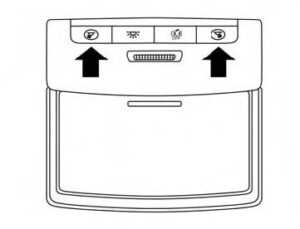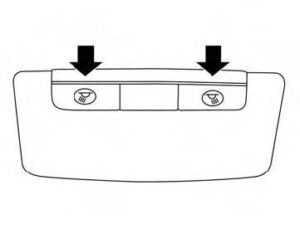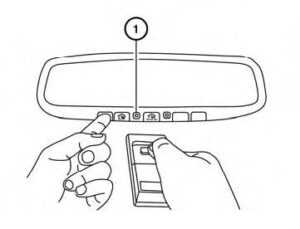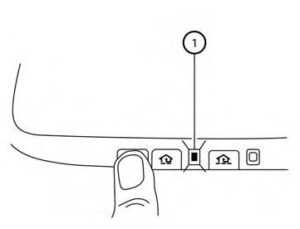Nissan ALTIMA 2023 Interior Lights and HomeLink® Universal Transceiver User Guide
The 2023 Nissan Altima is a midsize sedan that boasts a range of advanced features designed to improve the driving experience. One of the standout features of the Altima’s interior is its advanced lighting system, which includes ambient lighting, interior accent lighting, and LED headlights. The ambient lighting provides a soft and relaxing glow to the cabin, while the interior accent lighting adds a touch of elegance and sophistication. The LED headlights offer improved visibility and efficiency, making driving at night easier and safer. Another innovative feature of the Nissan Altima 2023 is the HomeLink Universal Transceiver, which allows drivers to control their home’s garage door, security system, and other compatible devices from their car. The HomeLink system is integrated into the vehicle’s rearview mirror, providing an easy-to-use interface. With this feature, drivers can easily access and control their home’s systems without the need for additional remotes or devices. These two advanced features, along with many others, make the Nissan Altima 2023 an excellent choice for drivers seeking comfort, convenience, and innovation in their sedan.
INTERIOR LIGHTS

- The interior light can be turned on regardless of the door position. The light will go off after a period of time unless the ignition switch is placed in the ON position when any door is opened.
- The interior lights can be set to operate when the doors are opened. To turn off the interior lights when a door is open, push the switch, the interior lights will not illuminate, regardless of the door position.
The lights will go off when the ignition switch is placed in the ON position, or the driver’s door is closed and locked. The lights will also go off after a period of time when the doors are open.
NOTE:
The step lights (if so equipped) illuminate when the driver and passenger doors are opened regardless of the interior light switch position. These lights will turn off automatically after a period of time while doors are open to prevent the battery from becoming discharged.
CAUTION
Do not use it for extended periods of time with the engine stopped. This could result in a discharged battery.

MAP LIGHTS
To turn the map lights on, push the switches. To turn them off, push the switches again.
CAUTION
Do not use for extended periods of time with the engine stopped. This could result in a discharged battery.
PERSONAL LIGHTS
To turn the rear personal lights on, push the switch. To turn them off, push the switch again.
TRUNK LIGHT
The light illuminates when the trunk lid is opened. When the trunk lid is closed, the light goes off.
The light will go off after a period of time if the trunk lid is left open unless the ignition switch is placed in the ON position.
For additional information, see “Exterior and interior lights” (P. 8-25).
HOMELINK® UNIVERSAL TRANSCEIVER (if so equipped)
The HomeLink® Universal Transceiver provides a convenient way to consolidate the functions of up to three individual hand-held transmitters into one built-in device.
HomeLink® Universal Transceiver:
- Will operate most radio frequency devices such as garage doors, gates, home, and office lighting, entry door locks, and security systems.
- Is powered by your vehicle’s battery. No separate batteries are required. If the vehicle’s battery is discharged or is disconnected, HomeLink® will retain all programming.
When the HomeLink® Universal Transceiver is programmed, retain the original transmitter for future programming procedures (Example: new vehicle purchases). Upon sale of the vehicle, the programmed HomeLink® Universal Transceiver buttons should be erased for security purposes. For additional information, see “Programming HomeLink®” (P. 2-92).
WARNING
- Your vehicle’s engine should be turned off while programming the HomeLink® Universal Transceiver. For additional information, see “Push-button ignition switch” (P. 5-13). Do not breathe exhaust gases; they contain colorless and odorless carbon monoxide. Carbon monoxide is dangerous. It can cause unconsciousness or death.
- Do not use the HomeLink® Universal Transceiver with any garage door opener that lacks safety stop and reverse features as required by federal safety standards. (These standards became effective for opener models manufactured after April 1, 1982.) A garage door opener that cannot detect an object in the path of a closing garage door and then automatically stop and reverse does not meet current federal safety standards. Using a garage door opener without these features increases the risk of serious injury or death.
- During the programming procedure, your garage door or security gate will open and close (if the transmitter is within range). Make sure that people or objects are clear of the garage door, gate, etc., that you are programming.
PROGRAMMING HOMELINK®
If you have any questions or are having difficulty programming your HomeLink® buttons, refer to the HomeLink® website at: www.homelink.com or call 1-800-355-3515.
NOTE:
Place the ignition switch in the ON position (without starting the engine) when programming HomeLink®. It is also recommended that a new battery be placed in the hand-held transmitter of the device being programmed to HomeLink® for quicker programming and accurate transmission of the radio frequency.
- Position the end of your hand-held transmitter 1–3 in (2–8 cm) away from the HomeLink® surface, keeping the HomeLink® indicator light 1O in view.

- Using both hands, simultaneously press and hold the desired HomeLink® button and hand-held transmitter button. DO NOT release until the HomeLink® indicator light 1O flashes slowly and then rapidly. When the indicator light flashes rapidly, both buttons may be released.(The rapid flashing indicates successful programming.)NOTE:
Some devices may require you to replace Step 2 with the cycling procedure noted in “Programming HomeLink® for Canadian customers and gate openers” in this section. - Press and hold the programmed HomeLink® button and observe the indicator light.
- If the indicator light 1O is solid/continuous, programming is complete and your device should activate when the HomeLink® button is pressed and released.
- If the indicator light 1O blinks rapidly for 2 seconds and then turns to a solid/continuous light, continue with Steps
4- 6 for a rolling code device. A second person may make the following steps easier. Use a ladder or other device. Do not stand in your vehicle to perform the next steps.
- At the receiver located on the garage door opener motor in the garage, locate the “learn” or “smart” button (the name and color of the button may vary by manufacturer but it is usually located near where the hanging antenna wire is attached to the unit). If there is difficulty locating the button, reference the garage door opener’s manual.
- Press and release the “learn” or “smart” button.
NOTE:
Once the button is pressed, you have approximately 30 seconds to initiate the next step. - Return to the vehicle and firmly press and hold the trained HomeLink® button for 2 seconds and release. Repeat the “press/hold/release” sequence up to three times to complete the training process. HomeLink® should now activate your rolling code-equipped device.
- If you have any questions or are having difficulty programming your HomeLink® buttons, refer to the HomeLink® web site at: www.homelink.com or call
1- 800-355-3515.
PROGRAMMING HOMELINK® FOR CANADIAN CUSTOMERS AND GATE OPENERS
Canadian radio-frequency laws require transmitter signals to “time-out” (or quit) after several seconds of transmission –which may not be long enough for HomeLink® to pick up the signal during training. Similar to this Canadian law, some U.S. gate operators are designed to “timeout” in the same manner.
If you live in Canada or you are having difficulties training a gate operator or garage door opener by using the “Training” procedures, replace “Programming HomeLink®” step 2 with the following:
NOTE:
When programming a garage door opener, etc., unplug the device during the “cycling” process to prevent possible damage to the garage door opener components.
- For additional information, see “Programming HomeLink®” step 1, (P. 2-92).
- Using both hands, simultaneously press and hold the desired HomeLink® button and the hand-held transmitter button. During training, your hand-held transmitter may automatically stop transmitting. Continue to press and hold the de-sired HomeLink® button while you press and re-press (“cycle”) your hand-held transmitter every 2 seconds until the frequency signal has been learned. The HomeLink® indicator light will flash slowly and then rapidly after several seconds upon successful training. DO NOT release until the HomeLink® indicator light flashes slowly and then rapidly. When the indicator light flashes rapidly, both buttons may be released. The rapid flashing indicates successful training. Proceed with “Programming HomeLink®” step 3 to complete.
If the device was unplugged during the programming procedure, remember to plug it back in when programming is completed.
OPERATING THE HOMELINK® UNIVERSAL TRANSCEIVER
The HomeLink® Universal Transceiver, after it is programmed, can be used to activate the programmed device. To operate, simply press and release the appropriate programmed HomeLink® Universal Transceiver button. The amber indicator light will illuminate while the signal is being transmitted. For convenience, the hand-held transmitter of the device may also be used at any time.
PROGRAMMING TROUBLE- DIAGNOSIS
If the HomeLink® does not quickly learn the hand-held transmitter information:
- Replace the hand-held transmitter batteries with new batteries.
- Position the hand-held transmitter with its battery area facing away from the HomeLink® surface.
- Press and hold both the HomeLink® and hand-held transmitter buttons without interruption.
- Position the hand-held transmitter1-3 inches (26 – 76 mm) away from the HomeLink® surface. Hold the transmitter in that position for up to 15 seconds. If HomeLink® is not programmed within that time, try holding the transmitter in another position – keeping the indicator light in view at all times.
If you have any questions or are having difficulty programming your HomeLink® buttons, refer to the HomeLink® website at: www.homelink.com or call 1-800-355-3515.
CLEARING THE PROGRAMMED INFORMATION
The following procedure clears the programmed information from both buttons. Individual buttons cannot be cleared. However, individual buttons can be reprogrammed. For additional information, see “Reprogramming a single HomeLink® but-ton” (P. 2-95).
To clear all programming:
- Press and hold the two outer HomeLink® buttons until the indicator light begins to flash in approximately 10 seconds. Do not hold for longer than 20 seconds.
- Release both buttons.
HomeLink® is now in the programming mode and can be programmed at any time beginning with “Programming HomeLink®” – Step 1.
REPROGRAMMING A SINGLE HOMELINK® BUTTON
To reprogram a HomeLink® Universal Transceiver button, complete the following:
- Press and hold the desired HomeLink® button. DO NOT release the button.
- The indicator light will begin to flash after 20 seconds. Without releasing the HomeLink® button, proceed with “Programming HomeLink®” – Step 1 (P. 2-92).
For questions or comments, contact HomeLink® at: www.homelink.com or 1–800–355–3515 (except in Mexico).
The HomeLink® Universal Transceiver but-ton has now been reprogrammed. The new device can be activated by pressing the HomeLink® button that was just programmed. This procedure will not affect any other programmed HomeLink® buttons.
IF YOUR VEHICLE IS STOLEN
If your vehicle is stolen, you should change the codes of any non-rolling code device that has been programmed into HomeLink®. Consult the Owner’s Manual of each device or call the manufacturer or dealer of those devices for additional information.
When your vehicle is recovered, you will need to reprogram the HomeLink® Uni-versal Transceiver with your new transmitter information.
FCC Notice:
For USA:
This device complies with Part 15 of the FCC Rules. Operation is subject to the following two conditions: (1) This device may not cause harmful interference, and (2) this device must accept any interference received, including interference that may cause undesired operation.
NOTE:
Changes or modifications not expressly approved by the party responsible for compliance could void the user’s authority to operate the equipment.
2-96 Instruments and controls
For Canada:
This device contains license-exempt transmitter(s)/receiver(s) that comply with Innovation, Science and Economic Development Canada’s license-exempt RSS(s). Operation is subject to the following two conditions: (1) This device may not cause interference. (2) This de-vice must accept any interference, including interference that may cause un-desired operation of the device.
Q&A
- What is the ambient lighting system in the Nissan Altima 2023?
The ambient lighting system in the Nissan Altima 2023 is a soft glow that illuminates the cabin, creating a relaxing and comfortable atmosphere for passengers.
- What is the purpose of the interior accent lighting in the Nissan Altima 2023?
The purpose of the interior accent lighting in the Nissan Altima 2023 is to add a touch of elegance and sophistication to the interior of the car.
- What type of headlights does the Nissan Altima 2023 have?
The Nissan Altima 2023 comes with LED headlights, which offer improved visibility and efficiency.
- What is the HomeLink Universal Transceiver in the Nissan Altima 2023?
The HomeLink Universal Transceiver is a feature in the Nissan Altima 2023 that allows drivers to control their home’s garage door, security system, and other compatible devices from their car.
- How is the HomeLink Universal Transceiver integrated into the Nissan Altima 2023?
The HomeLink Universal Transceiver is integrated into the rearview mirror of the Nissan Altima 2023, providing a seamless and easy-to-use interface.
- What other devices can be controlled with the HomeLink Universal Transceiver in the Nissan Altima 2023?
In addition to the garage door and security system, the HomeLink Universal Transceiver in the Nissan Altima 2023 can also control other compatible devices, such as home lighting systems.
- Can the HomeLink Universal Transceiver in the Nissan Altima 2023 be programmed with multiple devices?
Yes, the HomeLink Universal Transceiver in the Nissan Altima 2023 can be programmed with multiple devices, allowing drivers to control different aspects of their home from their car.
- Is the interior lighting in the Nissan Altima 2023 customizable?
Yes, the interior lighting in the Nissan Altima 2023 is customizable, allowing drivers to choose from a range of colors and brightness levels.
- How does the ambient lighting in the Nissan Altima 2023 affect the driving experience?
The ambient lighting in the Nissan Altima 2023 can enhance the driving experience by creating a relaxing and comfortable atmosphere for both the driver and passengers.
- Can the interior accent lighting in the Nissan Altima 2023 be turned off?
Yes, the interior accent lighting in the Nissan Altima 2023 can be turned off if desired.
- Is the HomeLink Universal Transceiver in the Nissan Altima 2023 compatible with all garage door openers?
The HomeLink Universal Transceiver in the Nissan Altima 2023 is compatible with most garage door openers, although some older models may not be compatible.
- Is the HomeLink Universal Transceiver in the Nissan Altima 2023 easy to program?
Yes, the HomeLink Universal Transceiver in the Nissan Altima 2023 is easy to program, and the process can be completed in just a few simple steps.
- Can the HomeLink Universal Transceiver in the Nissan Altima 2023 be programmed remotely?
No, the HomeLink Universal Transceiver in the Nissan Altima 2023 must be programmed from inside the car.
- Can the LED headlights in the Nissan Altima 2023 be adjusted?
Yes, the LED headlights in the Nissan Altima 2023 can be adjusted to provide the optimal level of brightness and visibility.
- What other advanced features does the Nissan Altima 2023 offer?
In addition to the interior lights and HomeLink Universal Transceiver, the Nissan Altima 2023 offers a range of advanced features, including a touchscreen infotainment system, Apple CarPlay and Android Auto compatibility, and a suite of advanced safety features.
Useful Links
View Full User Guide: Nissan ALTIMA 2023 User Guide
Download Manuals: https://www.nissanusa.com/owners/ownership/manuals-guides.html


